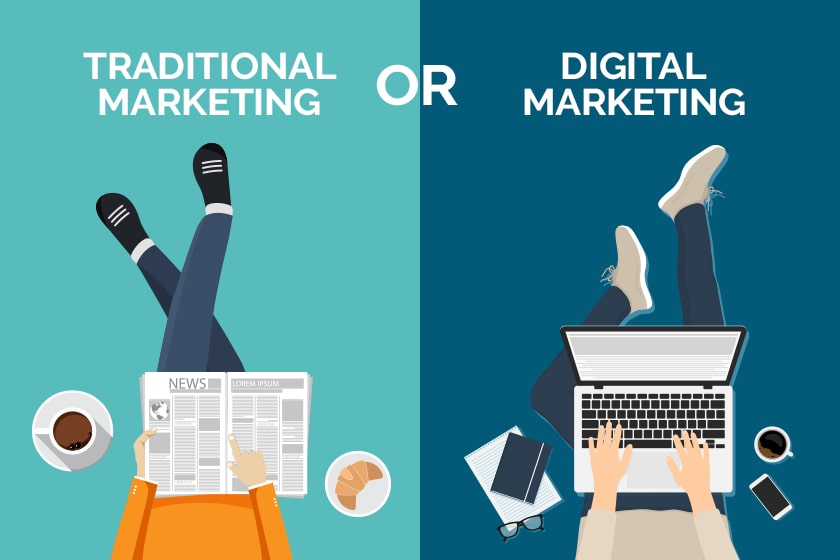In today’s fast-paced business landscape, marketing has undergone a significant transformation with the rise of digital platforms. The power and reach of digital marketing are now challenging traditional marketing methods that once reigned supreme. This article delves into a comprehensive analysis of traditional and digital marketing, highlighting their key differences, advantages, and business implications.
Understanding Traditional Marketing
Traditional marketing refers to the conventional methods used to promote products or services before the advent of the Internet and digital technologies. It encompasses various offline channels such as print advertisements, billboards, television commercials, radio spots, and direct mail campaigns. Businesses have long relied upon these methods to reach their target audience and create brand awareness.
Exploring Digital Marketing
Digital marketing, on the other hand, revolves around utilizing online platforms and technologies to promote products or services. It encompasses various channels, including search engine optimization (SEO), social media marketing, content marketing, email campaigns, influencer collaborations, and pay-per-click (PPC) advertising. Digital marketing offers businesses unparalleled opportunities to connect with their target audience in real time and engage them through interactive and personalized content.
Key Differences Between Traditional and Digital Marketing
- Cost-Effectiveness: Traditional marketing campaigns often require substantial financial investments, especially for advertisements in prime time slots or prominent print publications. In contrast, digital marketing allows businesses of all sizes to implement cost-effective strategies, targeting specific demographics without breaking the bank.
- Reach and Targeting: Traditional marketing campaigns have limited reach and targeting capabilities compared to digital marketing. With digital platforms, businesses can precisely define their target audience based on demographics, interests, and online behavior. This level of precision enables them to deliver tailored messages and offers to the right people at the right time.
- Measurability and Analytics: One of the significant advantages of digital marketing is the ability to track and measure campaign performance with great accuracy. Through advanced analytics tools, businesses can monitor key metrics such as website traffic, conversion rates, customer engagement, and return on investment (ROI). This data-driven approach empowers marketers to optimize their strategies and allocate resources more effectively.
- Interactivity and Engagement: Digital marketing provides interactive platforms where businesses can actively engage with their audience. Through social media channels, live chats, and user-generated content, brands can foster two-way communication, build customer relationships, and generate valuable feedback. Traditional marketing methods, although impactful, often need more interactivity and personalization.
- Flexibility and Adaptability: Digital marketing offers flexibility and adaptability that traditional marketing struggles to match. With digital campaigns, businesses can quickly adjust their strategies based on real-time data and market trends. This agility allows them to stay relevant, respond to customer needs promptly, and outpace competitors in the dynamic online landscape.
FAQs (Frequently Asked Questions)
Q: Which marketing approach is more cost-effective for small businesses?
A: Digital marketing provides a cost-effective solution for small businesses because it can target specific audiences and optimize limited budgets.
Q: Can digital marketing completely replace traditional marketing?
A: While digital marketing has gained prominence, traditional marketing still holds value in certain industries and target demographics. Employing an integrated marketing approach that combines both methods is often beneficial.
Q: How long does it take to see results with digital marketing?
A: The timeline for seeing results in digital marketing varies based on factors such as industry, competition, and campaign strategy. However, businesses can often observe initial improvements within a few months, with continued growth.
Q: Which digital marketing channels are most effective for lead generation?
A: Channels such as search engine marketing (SEM), content marketing, and social media advertising have proven effective for lead generation, offering targeted reach and engagement opportunities.
Q: How can businesses measure the success of their digital marketing campaigns?
A: Key performance indicators (KPIs) such as website traffic, conversion rates, click-through rates (CTR), and customer acquisition cost (CAC) are commonly used to measure the success of digital marketing campaigns.
Conclusion
As the business landscape evolves, understanding the differences between traditional and digital marketing is crucial for achieving marketing success. While traditional marketing methods have their merits, digital marketing offers unparalleled opportunities for businesses to connect with their target audience, drive engagement, and achieve measurable results. By embracing the power of digital marketing, businesses can position themselves for growth and stay ahead in today’s competitive market.
